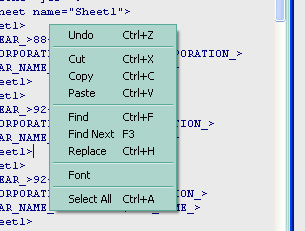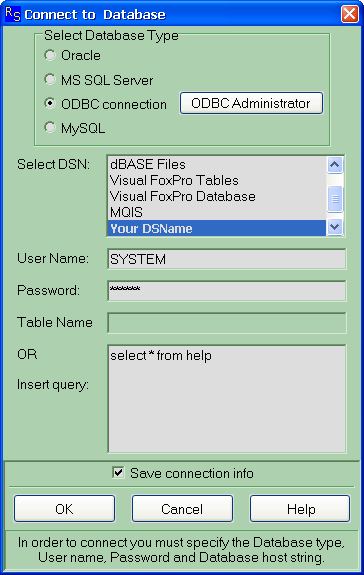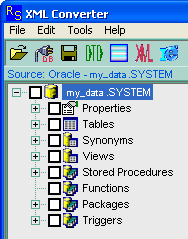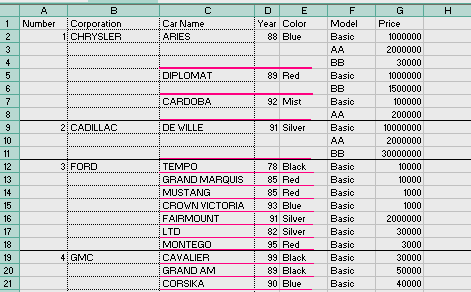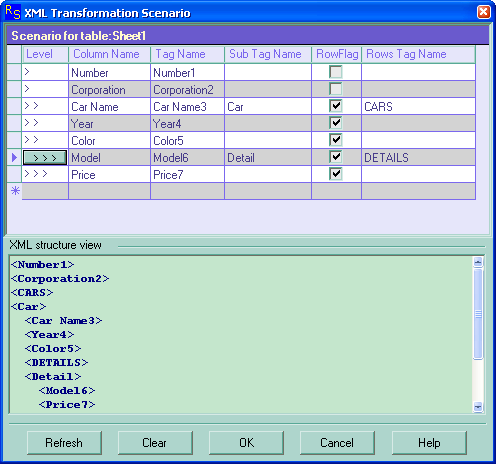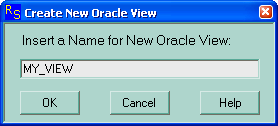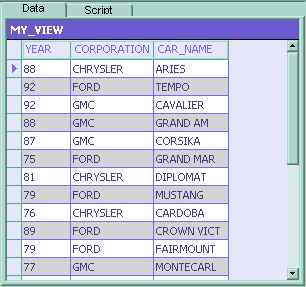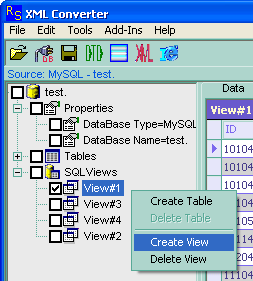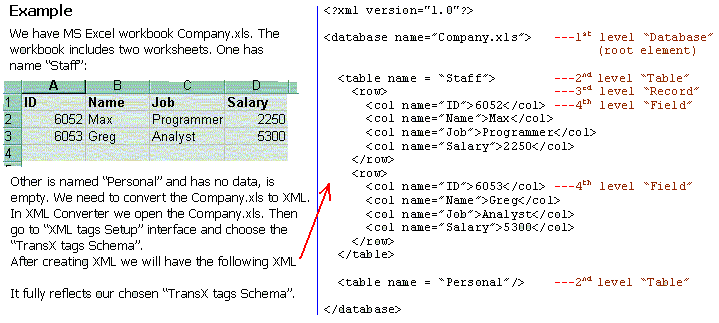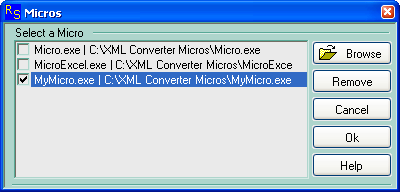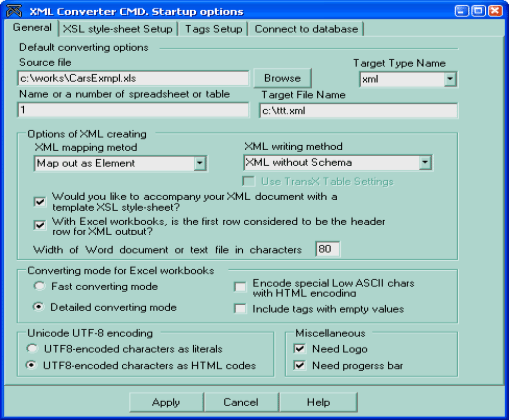XML Converter is the Windows based graphical transformation engine for creating XML documents from your database. It allows organizations to quickly and easily share information, captured within corporate data, with anyone in the world by utilizing established XML document definitions. Using this software, enterprises can share data with customers, suppliers or partners as well as distribute data across business units. XML Converter is great for producing fast, static, simple, data-driven XML documents.
Just choose your data source, select transformation methods, and generate the XML. This tool quickly and easily converts source data from Microsoft Access .mdb databases, Microsoft Excel .xls books, MS Word .doc document or text .txt file. XML Converter supports major databases such as Oracle, MySQL and MS SQL Server. In the future it will handle also any ODBC database. Once you've selected a table, you can control the output by choosing between several XML writing and mapping transformation methods. The XML Converter allows you to browse source data and make analysis of data source structure. This software has database navigation features that provide the ability to view your entire source file. It allows users to see source files that they are opening for converting. Also after converting you can review and edit destination XML document.
XML Converter takes all the guesswork out of designing and authoring database publishing projects from start to finish. You don’t need to know any Extensible Markup Language (XML) or Extensible Style Language (XSL). Besides creating an XML document the XML Converter will allow you to generate special XSL document, which will accompany your final XML document with a template XSL style-sheet. Both of these files can be used for your further needs such as: web-applications, reports, presentations, and so on. The elegant tabbed design assists you through the transformation process.
XML Converter is designed for both 32-bit and 64-bit operating systems and works under the Microsoft® .NET Framework.
The XML Converter runs on:
- Microsoft Windows NT® 4.0 (SP
6a required)
- Microsoft Windows 2000 (SP2 Recommended)
- Microsoft Windows XP Professional
- Microsoft Windows XP Home Edition
- Microsoft Windows Vista Family
- Microsoft Windows 7 Family
(Windows 95/98/ME and Windows 3.1 systems are not supported)
Software Requirements:
Microsoft Internet Explorer 5.01 or later (install
Internet Explorer 6.0)
To author with XML Converter, your system should be equipped with the following:
Pentium 90 MHz (minimum) or faster (recommended)
32 MB RAM (minimum) or more (96 MB or more recommended)
50 MB free disk space (minimum) or more
Important: Do not open a Microsoft Excel file (or MS Word file) that is
being used as a source during the XML Converter execution, because a "file
in use" error will occur.
License Agreement
Before installing RS XML Converter please read carefully terms and conditions of this agreement. You will express your consent to be bound by the terms of this Agreement by obtaining or opening Software media package. If you do not agree to all terms of this agreement do not use Software and destroy all copies of Software from your computer.
Grant of license:
Rustemsoft (the Developer) grants you (the Customer) a worldwide, non-exclusive, non-transferable, personal license to install and use the accompanying XML Converter (the Software) in the manner provided herein.
1. Software is licensed, not sold. Software is protected by copyright law, international copyright treaty provisions and other intellectual property laws and treaties. Customer must not allow copies of Software or any part of it to be made or distributed to anyone else. Customer may make backup copies of Software for archival purposes only.
2. Software is licensed for use on a single computer. Customer may delete Software from one computer and reinstall it on another, but Customer may not install Software on more than one computer at any given time without Developer's prior written permission.
3. Software may not be rented, leased, nor in any other manner commercially exploited without Developer's prior written permission.
4. Developer makes no representations or warranties about the suitability of this Software for any purpose. Software is provided 'as is' without express or implied warranties, including warranties of merchantability and fitness for a particular purpose or non-infringement. Developer may not issue updates to this Software.
5. All data sources accessed through Software is the property of the applicable content owner and may be protected by applicable copyright law.This license gives Customer no rights to such content, and Developer disclaims any liability for misuse of data sources.
6. Title, ownership rights, and intellectual property rights in and to Software shall remain with Developer. Customer agrees not to modify Software or attempt to decipher, disassemble, decompile or reverse engineer Software. Reproduction and/or redistribution of any portion of Software is prohibited without Developer's prior written permission.
7. Developer may terminate this license at any time by delivering notice to Customer and Customer may terminate this license at any time by destroying or erasing Customer's copy of Software. Upon termination of this license, Customer agrees to destroy all copies of Software. In case of termination sections 4 through 10 of this agreement shall indefinitely survive its termination. This license is the complete statement of the agreement between Developer and Customer and merges and supersedes all other or prior understandings, purchase orders, agreements and arrangements.
8. Developer or its suppliers shall not be liable for direct, incidental, consequential, special or indirect damages of any sort whatsoever. This includes loss of business profits, revenues, information, or business interruption resulting from Customer's use of Software or inability to use Software, even if Developer has been informed of the possibility of such damages.
9. This Software is not fault-tolerant. It is not designed, manufactured or intended for use in hazardous environments requiring fail-safe performance. Developer and its suppliers specifically disclaim any express or implied warranty of fitness for high-risk activities.
10. Developer reserves the right to discontinue distribution and/or support of its products at any time without notice. Developer reserves the right to change the prices of its products and services at any time without notice. Developer reserves the right to put Customer's company name on User representative list at Rustemsoft web site.
Complete agreement:
This Agreement is the entire agreement between you and Developer relating to its subject matter. This Agreement may not be modified other than in writing executed by Rustemsoft.
Copyright © 2001-2024Rustemsoft. All rights reserved.
XML Converter is "Shareware". This means that we have made the software available to you for the trial. The evaluation is not slideshow presentation. You can create, format, map, view, edit an XML output. It is fully functional but you can use it for limited time only. And then, if you decide to buy the software, you must register your copy with us.
Evaluation version (non-registered) of XML Converter is a "full-featured" release. This means that the same capabilities available in the registered software are present in the non-registered software. This allows you to try out all the features in XML Converter to confirm that they work to your satisfaction.
Registration entitles you free technical support for 30 days and free minor upgrades to the software. Registration may also entitle you to discounts on new software releases from Rustemsoft. Developer will also send you information bulletins by email to let you know about what’s happening with Rustemsoft products.
Finally, by registering the software, you provide us with the resources and incentive to support the software with updates and to develop additional quality products in the future.
Point your browser to one of the following Order
Forms to register online:
XML Converter Standard Edition
XML Converter with command-line interface
XML Converter Professional Edition
1. Run XML Converter
2. Open Source file by using 'Open' dialog box
3. Choose a spreadsheet (or table), which you want to convert from opened Microsoft Access .mdb databases, Microsoft Excel .xls books, MS Word .doc document, Oracle table / view, or text .txt file.
4. To start data transformation just click one of destination file type buttons: DTD, XSD or XML
5. After reviewing or editing your destination file in special window you can save the file by using 'Save' dialog box
The XML Converter main window is split into two sections (Source and Target). Each section is split into two vertically-aligned panes.
The left pane of Source section displays a hierarchical view of Data Source objects or containers in a tree-like structure. A container is a Data Source object that can hold other Data Source objects, including other containers.

For example, the "CarsExmpl.xls" displayed above is a container that holds the Table folders and the properties folder. Data Source is at the root of the tree.
The right pane of Source section displays the contents of the container that is selected in the left pane.
The right Target section displays the content of Target – DTD, XSD or XML output. It presents XML output in
three interface pages: XML Tree, XML Grid and XML Script. The right pane of Target section gives you ability to browse and edit final XML
content in any of these three windows. The left pane of Target section shows you a Schema of your final XML output. You can change the appearance of panes in the Options dialog.
